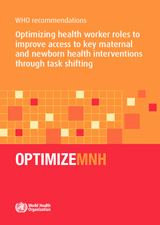
Human resource shortages in the health services are widely acknowledged as a threat to the attainment of the health-related Millennium Development Goals (MDGs). Attempts to optimize the potential of the existing health workforce are therefore crucial. A more rational distribution of tasks and responsibilities among cadres of health workers is seen as a promising strategy for improving access and costeffectiveness within health systems.
For example, access to care may be improved by training and enabling ‘mid-level’ and ‘lay’ health workers to perform specific interventions that might otherwise be provided only by cadres with longer (and sometimes more specialized) training. Such task shifting strategies might be particularly attractive to countries that lack the means to improve access to care within short periods of time.
Strategies to optimize tasks and roles for the implementation of effective interventions have achieved variable success. This is partly because the effects of these strategies are dependent on varying local health contexts and are shaped by a range of often very different social, political and cultural systems. However, the question of which health-care providers can deliver effective interventions is also linked to wider global discussions about whether health workers with lower levels of training can safely deliver key interventions.
Within the arena of maternal and newborn health, for example, the implementation of contraceptive programmes and specific maternal health interventions (such as the use of uterotonics) is linked to wider debates about how task and role optimization can be achieved through task shifting. Consensus has emerged that there is a need to define which key interventions can safely and effectively be delivered by different cadres.
Objectives
These recommendations have been developed as part of the World Health Organization’s madate to provide normative guidance to its member states. The objective of this guidance is to issue evidence-based recommendations to facilitate universal access to key, effective maternal and newborn interventions through the optimization of health worker roles. The recommendations are intended for health policy-makers, managers and other stakeholders at a regional, national and international level.